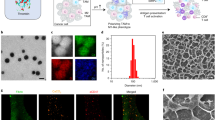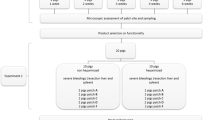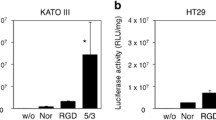Abstract
We report on the inhibition of wound implantation by TA3Ha mammary carcinoma cells by Arg-Gly-Asp containing proteins and peptides using a hepatic wedge resection model. Intravenously injected TA3Ha cells rarely form tumor in the liver of syngeneic mice, but after hepatic wedge resection, 45% (107/240) of the mice develop tumors in the hepatic wound. Hepatic wound implantation is significantly (P = 0.01) inhibited by pretreating the cells with whole mouse plasma, but not with fibrinogen-depleted plasma or serum. Tumor inhibition is also achieved by pretreatment of cells with fibrinogen (P = 0.05–0.0004), fibronectin (P = 0.007) and laminin, but not by albumin. The active domain appears to be the RGDS sequence since the deca- and tetrapeptides containing RGDS inhibit wound implantation (P < 0.05). However, the tetrapeptide Arg-Gly-Glu-Ser has no such activity. None of these agents affects ascites tumor formation by the intraperitoneally injected cells, suggesting that anchorage independent growth of cells is not affected. We propose that proteins and peptides containing RGD occupy the binding sites and prevent the cells from interacting with cell adhesion proteins in healing wounds. Proteins and/or peptides containing RGD may be useful for preventing local recurrence in postsurgical cancer patients.
Similar content being viewed by others
References
Ammirati M, Rao LN, Murthy MS, Buchmann T, Goldschmidt RA and Scanlon EF, 1989, Partial nephrectomy in mice with milliwatt carbon dioxide laser and its influence on experimental metastasis. Journal of Surgical Oncology, 64, 153–159.
Baker DG, Masterson TM, Pace R, Constable WC and Wanebo H, 1989, The influence of the surgical wound on local tumor recurrence. Surgery, 106, 525–532.
Fisher B and Fisher ER, 1959, Experimental studies of factors influencing hepatic metastasis. Annals of Surgery, 150, 731–744.
Fisher B, Fisher ER and Feduska N, 1967, Trauma and the localization of tumor cells. Cancer, 20, 23–30.
Murthy MS, Goldschmidt RA, Rao LN, Ammirati M, Buchmann T and Scanlon EF, 1989, Influence of surgical trauma on experimental metastasis. Cancer, 64, 2035–2044.
Rao LN, Murthy MS, Ammirati M, Goldschmidt RA and Scanlon EF, 1987, Influence of surgical trauma on experimental tumor metastasis. Proceedings of the American Association for Cancer Research, 28, 78.
Schakert HK and Fidler IJ, 1989, Development of an animal model to study the biology of recurrent colorectal cancer originating from mesenteric lymph system metastasis. International Journal of Cancer, 44, 177–181.
See WA and Chapman WH, 1987, Tumor cell implantation following neodymium YAG bladder injury: a comparison to electrocautery injury. Journal of Urology, 137, 1266–1269.
Sugarbaker EV, Ketcham AS and Cohen AM, 1971, Studies of dormant tumor cells. Cancer, 28, 545–552.
Whalen GF and Ingber DE, 1989, Inhibition of tumor cell attachment to extracellular matrix as a method for preventing tumor recurrence in a surgical wound. Annals of Surgery, 210, 758–764.
Bryon T, 1972, Tumour implantation in ischemic, thermic and mechanical lesions of the colonic mucosa. Acta Chirurgica Scandinavica, 138, 202–206.
Robinson KP and Hoppe E, 1962, The development of blood borne metastases: effect of local trauma and ischemia. Archives of Surgery, 85, 720–724.
Brown MJ, 1973, The effect of lung irradiation on the incidence of pulmonary metastases in mice. British Journal of Radiology, 46, 613–618.
Cole H and Halnan KE, 1971, Facilitation of tumor spread in irradiated tissue after prophylactic postoperative X-ray therapy for breast cancer. Clinical Radiology, 22, 133–135.
Fisher ER and Fisher B, 1969, Effects of X-irradiation on parameters of tumor growth, histology, and ultrastructure. Cancer, 24, 39–55.
Adamson IYR, Young L and Orr FW, 1987, Tumor metastasis after hyperoxic injury and repair of the pulmonary endothelium. Laboratory Investigation, 57, 71–77.
Agostino D and Cliffton EF, 1965, Trauma as a cause of localization of blood borne metastases: preventive effects of heparin and fibrinolysin. Annals of Surgery, 161, 97–102.
Alexander JW and Altemeier WA, 1964, Susceptibility of injured tissues to hematogenous metastasis: an experimental study. Annals of Surgery, 159, 933–944.
Adamson IYR, Orr FW and Young L, 1986, Effects of injury and repair of the pulmonary endothelium of lung metastasis after bleomycin. Journal of Pathology, 150, 279–287.
Orr FW, Adamson IYR and Young L, 1986, Promotion of pulmonary metastasis in mice by bleomycininduced endothelial injury. Cancer Research, 46, 891–897.
Albelda SM and Buck CA, 1990, Integrins and other cell adhesion molecules. Federation of the American Society for Experimental Biology Journal, 4, 2868–2880.
Cardinali M, Uchino R and Chung SI, 1990, Interaction of fibrinogen with murine melanoma cells: covalent association with cell membranes and protection against recognition by lymphocyte-activated killer cells. Cancer Research, 50, 8010–8016.
Cheresh DA and Spiro RC, 1987, Biosynthetic and functional properties of an Arg-Gly-Asp-directed receptor involved in human melanoma cell attach ment to vitronectin, fibrinogen, and von Willebrand factor. Journal of Biological Chemistry, 262, 17703–17711.
Rouslahti E, 1991, Integrin. Journal of Clinical Investigations, 87, 1–5.
Murthy MS, Summaria LJ, Miller RJ, Wyse TB, Goldschmidt RA and Scanlon EF, 1991, Inhibition of tumor implantation at sites of trauma by plasminogen activators. Cancer, 68, 1724–1730.
Humphries MJ, Yamada KM and Olden K, 1988, Investigation of the biological effects of anti-cell adhesive synthetic peptides that inhibit experimental metastasis of B16-F10 murine melanoma cells. Journal of Clinical Investigations, 81, 782–790.
Ugen KE, Mahalingam M, Klein PA and Kao K-J, 1988, Inhibition of tumor cell-induced platelet aggregation and experimental tumor metastasis by the synthetic Gly-Arg-Gly-Asp-Ser peptide. Journal of the National Cancer Institute, 80, 1461–1466.
Gehlsen KR, Argraves WS, Pierschbacher MD and Ruoslahti E, 1988, Inhibition of in vitro tumor cell invasion by arg-gly-asp-containing synthetic peptides. Journal of Cell Biology, 106, 925–930.
Hauschka TS, Weiss L, Holdridge BD, Cudney TL, Zumpft M and Planinsek JA, 1971, Karyotypic and surface features of murine TA3 carcinoma during immunoselection in mice and rats. Journal of the National Cancer Institute, 47, 343–359.
Murthy MS, Rao LN, Khandekar JD and Scanlon EF, 1987, Enhanced therapeutic efficacy of cisplatin in combination with diethyldithiocarbamate and hyperthermia in a mouse model. Cancer Research, 47, 774–779.
Murthy MS, Travis JD and Scanlon EF, 1987, Factors influencing the growth and metastatic behavior of tumors. Journal of Surgical Oncology, 35, 44–49.
Niewiarowski S, Budzynski AZ, Morinelli TA, Brudzynski TM and Stewart GJ, 1981, Exposure of fibrinogen receptor on human platelets by proteo lytic enzymes. Journal of Biological Chemistry, 256, 917–925.
Rao LN, Ammirati M, Murthy MS, Goldschmidt RA, Ciric I and Scanlon EF, 1986, Milliwatt carbon dioxide laser and hepatic surgery in mice: surgical technique and pathology. Lasers in Surgery and Medicine, 6, 477–484.
Kurtz JM, Spitalier J-M, Amalric P, Brndone H, Ayme Y, Bressac C and Hans D, 1988, Mammary recurrences in women younger than forty. Inter national Journal of Radiation Oncology, Biology and Physics, 15, 271–276.
Scanon EF, 1985, Local recurrence in the pectoralis muscles following modified radical mastectomy for carcinoma. Journal of Surgical Oncology, 30, 149–151.
Sykes HF, Sim DA, Wong CJ, Cassady JR and Salmon SE, 1989, Local-regional recurrence in breast cancer after mastectomy and adriamycin based adjuvant chemotherapy: evaluation of the role of postoperative radiotherapy. International Journal of Radiation Oncology, Biology and Physics, 16, 641–647.
Feil WF, Kovats EK, Neuhold N, Schemper M, Wenzl E and Schiessel R, 1988, Rectal cancer: factors influencing the development of local recur rence after radical anterior resection. International Journal of Colorectal Diseases, 3, 195–200.
Rao AR, Kagan AR, Chan PM, Gilbert HA, Nussbaum H and Hintz BL, 1981, Patterns of recurrence following curative resection alone for adenocarci noma of the rectum and sigmoid colon. Cancer, 48, 1492–1495.
Novak R, Kern J, Fister H, Trnski D, Dimanovski J and Kraus O, 1988, Effects of chemotherapy and immunotherapy on the recurrence and progression of superficial bladder cancer. European Urology, 14, 367–370.
Yurchenco PD and Schittny JC, 1990, Molecular architecture of basement membranes. Federation of the American Society for Experimental Biology Journal, 4, 1577–1590.
Tressler RT, Belloni PN and Nicolson GL, 1989, Correlation of inhibition of adhesion of large cell lymphoma and hepatic sinusoidal endothelial cells by RGD-containing peptide polymers with metastatic potential: role of integrin dependent and-independent mechanisms. Cancer Communications, 1, 55–63.
Gould RJ, Polokoff MA, Friedman PA, Huang T-F, Holt JC, Cook JJ and Niewiarowski S, 1990, Disintegrins: a family of integrin inhibitory proteins from viper venoms. Proceedings of the Society of Experimental Biology and Medicine, 195, 168–171.
Terranova VP, Williams JE, Liotta LA and Martin GR, 1984, Modulation of the metastatic activity of melanoma cells by laminin and fibronectin. Science, 226, 982–985.
Cheresh DA, Pytela R, Pierschbacher MD, Klier FG, Rouslahti E and Reisfeld RA, 1987, An arggly-asp-directed receptor on the surface of human melanoma cells exists in a divalent cation-dependent functional complex with the disialoganglioside GD2. Journal of Cell Biology, 105, 1163–1173.
Johnson JP, Stade BG, Holzman B, Schwable W and Reithmuller G, 1989, De novo expression of intercellular-adhesion molecule 1 in melanoma correlates with increased risk of metastasis. Proceedings of the National Academy of Sciences U.S.A., 86, 641–644.
Massague J, 1990, The transforming growth factor-β family. Annual Review of Cell Biology, 6, 597–641.
Orr FW, Adamson IYR and Young L, 1985, Pulmonary inflammation generates chemotactic activity for tumor cells and promotes lung metastasis. American Review of Respiratory Diseases, 131, 607–611.
Spector WG and Willoughby DA, 1971, Vascular and cellular aspects of inflammation of the skin. Immunology and the Skin, edited by Montagna W and Billingham RE (New York: Appleton-CenturyCrofts), pp. 29–44.
Orr FW, Buchanan MR, Tron VA, Guy D, Laurie D and Saunder DN, 1988, Chemotactic activity of endothelial cell-derived interleukin-1 for human tumor cells. Cancer Research, 48, 6758–6763.
Dvorak HF, Senger DR and Dvorak AM, 1984, Fibrin formation: implications for tumor growth and metastasis. Hemostatic Mechanisms and Metastasis, edited by Hohn KV and Sloane BF (Boston: Martinus Nijhoff), pp. 94–114.
Weiss L, Orr FW and Hohn KV, 1988, Interactions of cancer cells with microvasculature during metastasis. Federation of the American Society for Experimental Biology Journal, 2, 12–21.
Dvorak HF, Senger DR and Dvorak AM, 1983, Fibrin as a component of the tumor stroma: origins and biological significance. Cancer Metastasis Review, 2, 41–73.
Gunji Y and Gorelik E, 1985, Role of fibrin coagulation in protection of murine tumor cells from destruction by cytotoxic cells. Cancer Research, 15, 579–582.
Zacharski LR, Constantini V, Wojtukiewicz MZ, Memoli VA and Kudryk BJ, 1990, Anticoagulants as cancer therapy. Seminars in Oncology, 17, 217–227.
Bottaro DP, Rubin JS, Faletto DL, Chan AM-L, Kmiecik TE, Vande Woude GF and Aaronson SA, 1991, Identification of the hepatocyte growth factor receptor as the c-met proto-oncogene product. Science, 251, 802–804.
Author information
Authors and Affiliations
Rights and permissions
About this article
Cite this article
Murthy, M.S., Weiss, B.D., Miller, R.J. et al. Inhibition of tumor implantation at sites of trauma by Arg-Gly-Asp containing proteins and peptides. Clin Exp Metast 10, 39–47 (1992). https://doi.org/10.1007/BF00163575
Received:
Accepted:
Issue Date:
DOI: https://doi.org/10.1007/BF00163575




